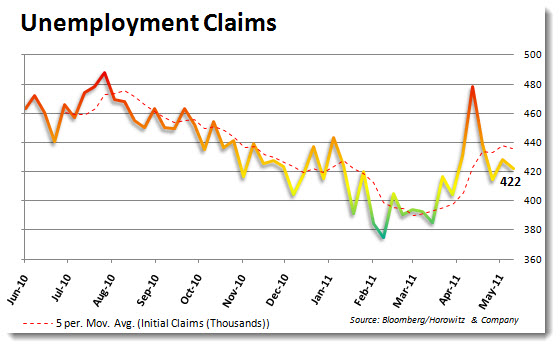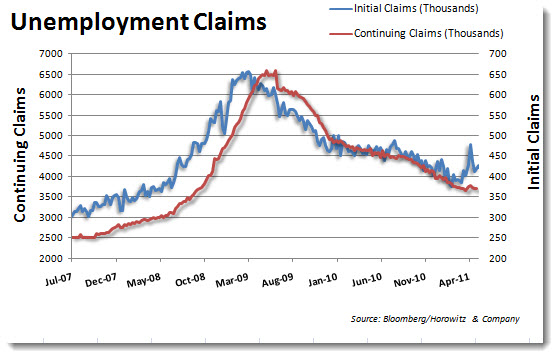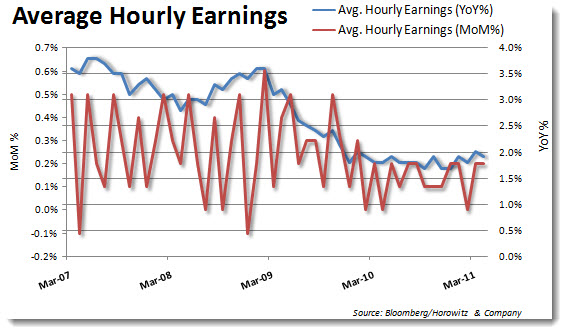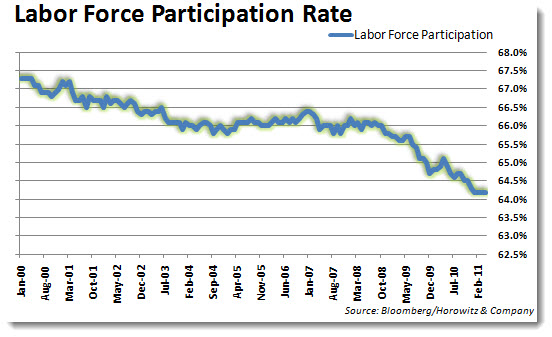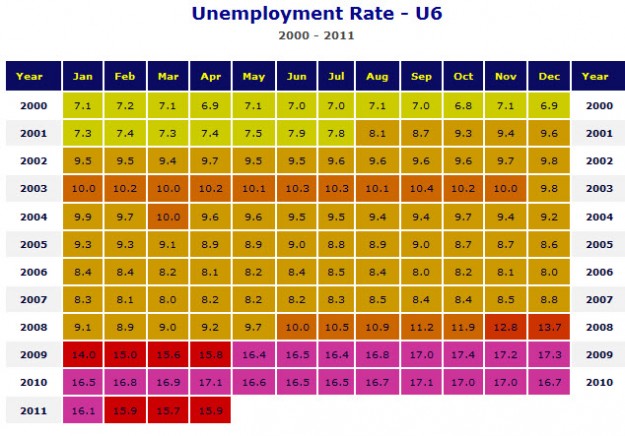2011-06-03
There was a great deal of action on Thursday as the highly anticipated initial claims release had the potential to shed some additional light on what to expect for Friday’s NFP report. Estimates have been coming down and now the concern is that without additional stimulus, the economy is going to stall.
The good news is that the initial claims number, while still over 400,000, it is below the 5 month average. The bad news is that the recent spike higher has also skewed the 5 month average higher.
Continuing claims are dropping and while politicians will be quick to tell us that this is good, the reality is that it is a simple process of claims termination that is causing this to fall. As fewer people receive benefits, there is a greater level of stress on the economy.
Add to that the fact that average hourly earnings are close to the lowest point since 2007 and it is a wonder how there is any money available for discretionary purchases. Truth be told, there probably isn’t much that is being spent on extra items these days by many Americans who rely on a regular paycheck. Rather, it is the enormous wealth that has been created by the emerging nations that has continued to support retail sales.
That tidbit was evident as we saw same-store-sales reports on Thursday and a large discrepancy between the lower-end priced goods and the upper-end.
Fortunately for some retailers, the U.S. dollar’s obliteration over the past year has created an ongoing garage sale for U.S. goods to foreigners. The highest ticket items continue to sell (Tiffany, Fossil, Coach, BMW etc) around the world as the lower cost items (WalMart, Target etc.) are embroiled in a price war to attract sales.
The test for the U.S. economy’s resilience/potential is going to be found in the NFP report. This will provide additional data as to the level of hiring for companies as they come up against margin pressures from higher input costs. We have been hearing a blaring undertone in conference calls regarding this concern as management believes that prices need to be raised along with additional expense cuts in order to continue their high level of profitability.
The media will be closely watching the unemployment rate in hopes of a drop from the 9% level. Even with less hiring, there is the potential for this rate to actually come down a bit. Analysts, on average, are predicting a drop to 8.9%, even as many have been lowering their payroll estimates after the shocking ADP report.
It is simply a statistical anomaly that is causing the rate to stay as “low” as it has. Since the rate is calculated using the number of unemployed that are eligible to work, the lower the labor participation rate, the more it has the effect of pushing down the unemployment rate. By the government’s definition, if you quit looking, you’re no longer counted as unemployed. And you’re no longer part of the labor force. So, discouraged workers that no longer are looking for a job, are not counted. This has helped to provide a much rosier picture of the employment situation in the U.S. since 2000.
The “real” unemployment rate (U6-underemployment rate) , take a broader definition and includes a much great number of individuals who are not working, but may be able to.
Looking at the participation rate and the table above provides a much better view of the actual level of unemployment. Even if there is a drop in the rate, it is important to consider more than just the headline number that will be reported.
There are two ways to look at what could play out after the release at 8:30am. One is that a better number will surprise markets to the upside as there is a very negative expectation of what is to come. Even a number close to the 150,000 level will provide a nice bounce for markets. On the other hand, a very strong or very weak number will be problematic.
If the report shows much stronger than expected hiring, there could be a sharp rally for the U.S. dollar, causing markets to fall as risk trades continue to unwind. The same result could be seen with a very weak number. Even though that is a negative for the U.S. dollar, it may create a flight to safety out of risk trades. There is little room for error with this report as the past two weeks has provided a series of negative economic prints.
Most traders are looking for a bounce to fade if the number is moderately strong. In the end, this report could provide the juice to push markets lower, continuing the recent trend or create a floor that will need to be justified by positive reports in the near future in order to be supported.


